Now & New
The Tides of Bingo, Part One: Onomichi Rises with Flowing Novelty
Every year in mid-July, Japan has a long weekend thanks to “Marine Day,” a public holiday designated as the third Monday in July with the aim of letting people put aside time to enjoy beaches and ports. The resulting three-day weekend (for those who work Monday to Friday), along with the fast-approaching school holidays and the gradual easing up on COVID-19 restrictions, has made for a wave of domestic tourism, particularly to seaside locations like Miyajima, Kure, Okunoshima, and who could forget Hiroshima City? Compound that with the possibility of international tourism starting as early as this summer, and coastal destinations are bound to have a tsunami of visitors on their hands. In fact, before the pandemic was a thing, tourism to Japan was already on the wax, and cities all over Hiroshima Prefecture were scrambling to renovate this and that to ensure top-notch facilities for their tourists. Although the eastern Bingo area (think Onomichi and Fukuyama) is less often visited than its western counterpart Aki (think Takehara, Kure, Hiroshima City, etc.), the former two cities have poured extensive effort and expenses into raising their appeal through the paradoxical phenomenon on being new and old at the same time. Over the long weekend in July, I took it upon myself to investigate each side of this coin by focusing on how each city facilitates a deeper appreciation of the sea.

Onomichi is usually noted for its old-timey charm thanks to its countless temples and retro cafés on its shopping arcades, but it cannot be denied that the city has been pushing for makeovers of places tourists frequent most. When it comes to enjoying the sea in Onomichi, aside from biking, driving, or walking the Shimanami Kaido, one other popular avenue is looking down on the Seto Inland Sea from a vantage point. Enter the Senkoji Park observation deck, which was refurbished and opened to the public on March 29th, mere days after I did my sakura temple walk. Since then, I had wanted to go back, but decided to hold off until the city’s next major touristy unveiling: a new hotel located on top of Onomichi Station.
Beacon of Hospitality
I timed my train to Onomichi so that I would arrive just in time for lunch, which I would eat at the new hotel’s restaurant. Finding the hotel was a cinch, for the instant I exited through the turnstile, I was greeted by a staircase directing me to HOTEL BEACON ONOMICHI, adorned on either side by tasteful artworks. Many tourists frantically walking in the direction of town stopped to stare at or take a picture of that “Baby Broker” poster, but only I had plans to ascend the stairs and see the newborn beacon for myself.

At the top of the stairs, a different sign pointed me in the direction of GEN, the name of HOTEL BEACON ONOMICHI’S café restaurant and bar. I walked toward the front door bracing myself for some high prices on the menu, but instead found my eyes glistening at the promotional poster just outside by the terrace. In honor of their grand opening, GEN was offering a limited-time, ultra-discounted lunch course menu, and only twenty servings would be prepared every day. After taking a photo of the seascape below from the terrace, I rushed inside to take full advantage of the breathtaking bargain.
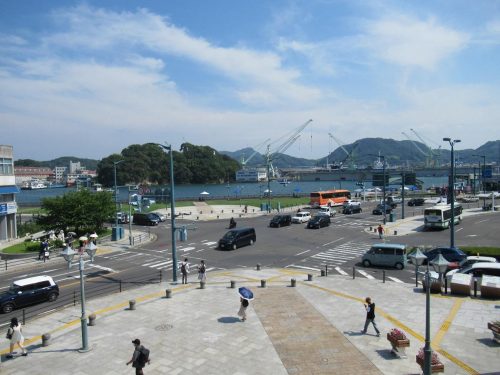
It wasn’t just the outside, but the window seating inside commanded views of Onomichi Port as well. As soon as I was seated and the waitress came to take my order, I inquired about the grand opening lunch special, and thankfully they had yet to run out of stock for the day. Minutes after my order was taken, the antipasto (starter) arrived at my table: grilled vegetables from Onomichi to be dipped into a warm, miso-based sauce in the style of bagna càuda. That came with the first plate of an unlimited supply of hot, fresh bread and butter that I could constantly request throughout the meal; I needed only say the word and it would be toasted and brought to me.

After I finished my antipasto and the waitress took up my plate, I was served the primo (first course), secondo (second course), and contorno (side dish) on the same platter and given a thorough explanation on everything I was about to ingest. The primo was a homemade clam chowder with the clams still in their shells, and the secondo was a surf and turf combo consisting of one oyster Rockefeller paired with a Taoshita beefsteak (product of Takehara) to be covered in Chaliapine sauce, all garnished with a contorno of potato wedges, carrots, and broccoli. Western though it may look, the recipe for this steak (as well as the origin of the beef) is Japanese indeed, inspired by Russian opera singer Fyodor Shalyapin (who spelled his surname “Chaliapine” in the West) when he stayed and dined at the Imperial Hotel in Tokyo in 1936. At the time, Shalyapin had a tooth removed, and worried that eating anything that involved a lot of chewing might be an ordeal for him. The cooks at the hotel restaurant “New Grill,” who wanted to accommodate Mr. Shalyapin while serving him a top-class meal, had the idea to tenderize steak into a flat, elongated form before marinating it with onions to further soften it, then cooking and topping it with finely chopped onions. Due to the steak’s popularity with Mr. Shalyapin himself, a dish called “Chaliapine Steak” was born, and to this day, the method and chopped onion sauce that accompanies the meat remains exclusive to Japan.
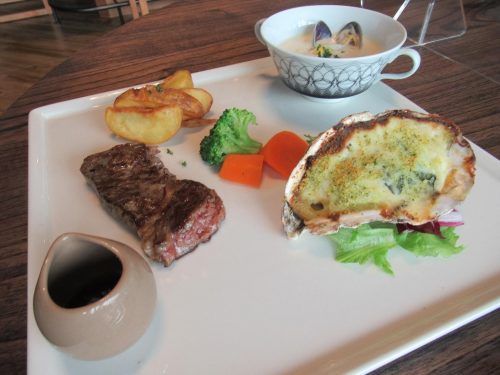
Moment of Joy: Giving and Taking, But Mostly Taking
From the advertisements alone, I knew GEN was a high-class restaurant, so before I ascended the stairs, I was expecting a hefty price tag even for its grand opening special lunch, only to be sorely mistaken. To describe today’s spread as a steal would be a grave understatement considering the quantity, quality, and presentation of all the dishes, from starter to dessert.
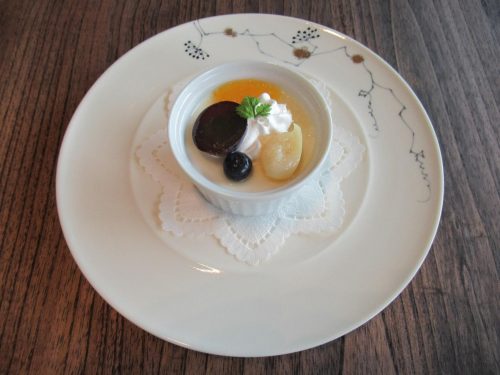
I had a grand time photographing each plate that came my way, concurrently sharing each step of my meal with my family in real time. On top of all that, the spectacular service from the staff had me feeling like an opera star myself!
Star Treatment
Upon finishing my lunch and paying, I had the bright idea to ask for a tour of the guest rooms, seeing as this hotel had just opened on the 13th,four days prior to my visit (I was expecting a gentle rejection). The woman behind the counter went into the back to ask permission to show me the rooms, and once she got the green light, she led me into the corridor behind the restaurant, where all sixteen guest rooms were located. I was only able to see the interior of one of the rooms, for which she exceedingly apologized, but that was good enough for me (she basically let me tour 6.75% of the entire accommodation space).
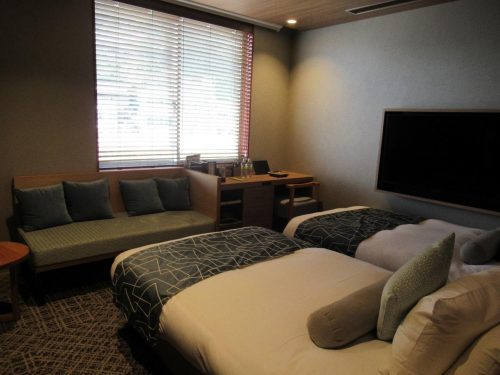
The room I was shown had two twin beds pushed together, a sofa for relaxation, a TV off to the side, and a projector on the ceiling accompanied by a retractable screen that fell before the window. To the left of the entrance, not pictured, were two bicycle racks mounted on the wall, included with every room so cycling aficionados can cleverly store their sets of wheels for the night and depart on the Shimanami Kaido first thing next morning. Beside the racks was the bathroom, which came with a rather roomy shower cell; more premium rooms would have a comfy bathtub, so if you want that, make sure to reserve the right type of room. This guest room was so pristine that I didn’t want to sully the carpet with my dirty sneakers, so I took whatever pictures I could from the entrance area, thanked the woman for her hospitality, and took off toward the most popular part of the city center.
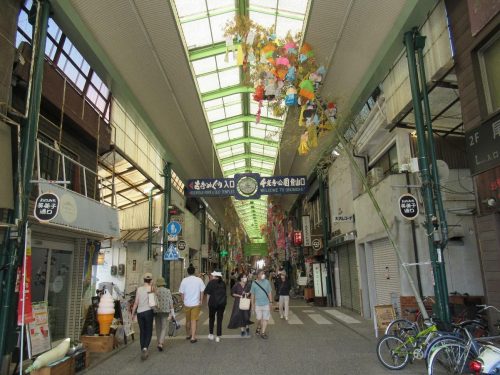
My ultimate goal was Senkoji Park, but to get there, I walked through Onomichi’s Hondori, which was decked out for Tanabata, the Star Festival. Historically, the festival took place on the seventh day of the seventh month of the Japanese lunar calendar, but since the country switched over to the Gregorian calendar, the holiday (sadly not a public holiday) now floats between July and August, with the actual date of observance varying among localities in Japan. Shopping streets in bigger cities like Sendai would blow passersby away with their ginormous, colorful streamers, but Onomichi keeps it simple with bamboo stalks leaning from the sides, each adorned with paper dolls made by local schoolchildren.
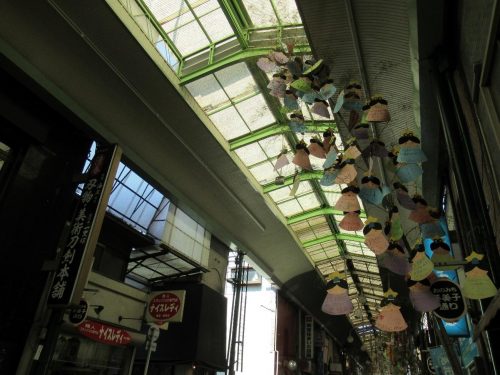
The children wrote their names and wishes onto the dolls before attaching the dolls to the bamboo stalks. Their wishes ranged from feasible—such as being able to ride in a fire truck—to more outlandish requests—for instance, to have one’s very own peregrine falcon or Shinkansen. Having additional splashes of color on Hondori thanks to the kids made the shopping arcade even more photogenic than it normally is.
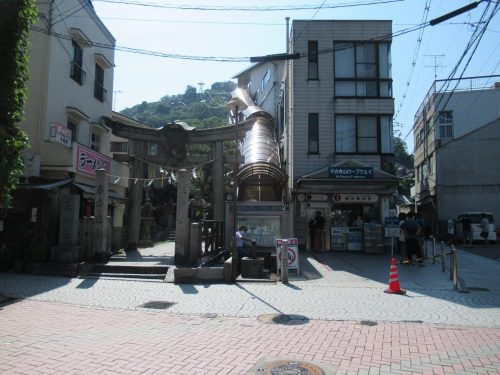
Before long, I reached the bottom ropeway station for Senkoji Park, adjacent to Ushitora Shrine. Of course, I had to wait in a line to buy my ticket, but considering that it was a Sunday afternoon, I was surprised that the line wasn’t longer. There was nothing new about the bottom station; the objective of this afternoon was to see how much the top station had changed since its debut less than four months ago, so up I went. Though the weather was hot, at least the sky was more beautiful than it was when I took the ropeway back in March, so no complaints here.
Peak of the Park
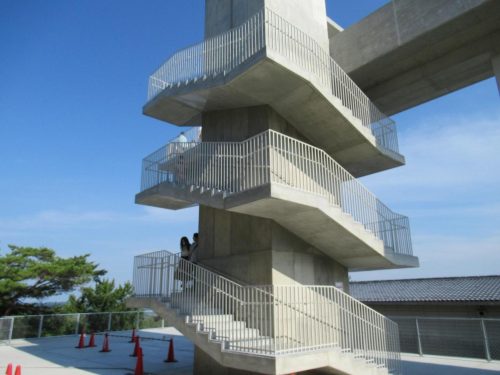
At the top, visitors hang a right to find an elevator and stairs leading to the Senkoji Summit Observatory PEAK, a spick-and-span, concrete vantage point with some amusing staircases and a bridge full of panorama photo opportunities connecting them. Most tourists who opt to take the stairs will choose this angular spiral to walk laps around the elevator while going up, though in actuality, both staircases experience two-way traffic, so do be considerate of opposing traffic and keep to the left side for smooth travel. Beside this staircase is a marker indicating “The Path of Literature,” a trail leading further down the hill featuring monuments honoring famous authors with excerpts of their works etched into stone.
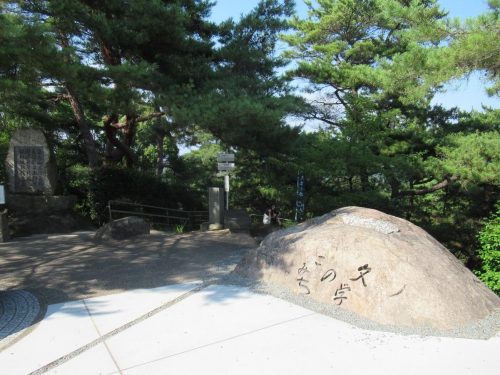
I leisurely made my way up the square spiral staircase, stopping in between to admire the landscape. It was at the top, however, that people gathered here and there to take panorama photos and selfies. The view below was taken from the vantage point at the left end, and yes, getting a clear photo like this requires waiting one’s turn and also some patience in dealing with possible photobombs from other tourists.

Along the bridge area were clusters of people snapping and filming, as well as others who casually stood chatting while admiring the scenery sans camera. In the distance, one could also see people on jet skis making the most out of the fine weather and water, but they were a bit hard to capture on camera due to their constant movements. Seeking a thrill of my own, at the right end of the bridge, I waited for the right moment to film a kiddy coaster experience by jogging down the circular spiral staircase.
Back down at the plaza, I paid a visit to the gift shop, which had an ample supply of citrus-flavored beverages and sweets, all of which could be enjoyed at the seating space just outside the store. Among their most popular products was the soft serve ice cream in flavors like Setouchi mikan, lemon, and Hassaku orange, as well as classic vanilla for the not-so-adventurous. Much as I wanted to have some of that tangy, orange or yellow ice cream, I was more thirsty than hungry, so I got myself a pink Setouchi lemonade float, with the lemonade being made from local lemons and naturally colored pink with the pigment of beets rather than with any artificial food coloring. I sat on one of the benches, took my commemorative snack photo, and recharged my batteries away from the blazing sun.
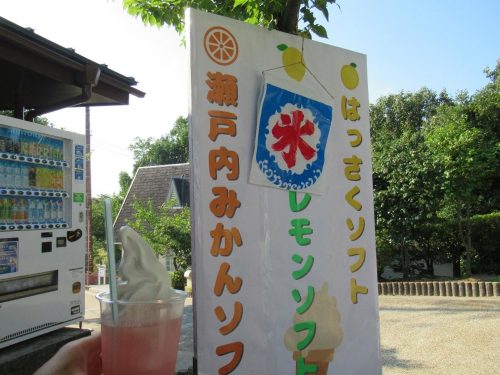
Lovely Sights
The fun doesn’t end at the PEAK, though, as many visitors would elect to walk down the hill to street level rather than take the ropeway once again. Meanwhile, in other parts of Senkoji Park, there is more scenery to be taken in, so I left the gift shop and started to walk downhill when a gated area caught my eye. The gate was crudely built and had a warning sign, initially making me think access was denied to tourists, but when I took a closer gander, all the sign said was, “To prevent the intrusion of wild boar, please make sure to close the gate and affix the latch after passing through.” Easy enough, but considering how flimsy the gate was, fiddling with the latch proved to be easier said than done. After it was said and done, though, I was greeted by this view.

Nothing too noteworthy here, save for a humble building whose purpose remains unknown, and a circular pathway surrounding a flower bed with barely any flowers. Another path jutted out of the other side of the roundabout, which led to a second crude gate with a similarly frustrating latch. Past that gate, the road forked, with the right path going full circle to the aforementioned Path of Literature, and the left path leading to “Eight Mat Rock.” The shape of the boulder did in fact resemble the floor of a tatami room, and although there was a view to be had from the rock, it didn’t come close to what visitors could see at the PEAK.

I backtracked to where I was, carefully bolting down both latches as I passed through the gates. From there, I gradually made my way towards the Lover’s Sanctuary, the plaza that I could see but couldn’t access about four months ago. The first thing to catch a repeat visitor’s eye would have to be this golden statue of a naked woman with her baby and a playful dog. This was a noteworthy piece that was once located at the base of the observatory before the renovations began.

Further into the plaza, there was a heart-shaped altar with a statue of two cats dedicated to eternal love, and I’m pretty sure this cute, feline couple is exclusive to Onomichi. Next to that was a rack with some heart-shaped padlocks latched onto the bars, many of which had the names and wishes of the donors written on them. Couples who wish to pray for everlasting love or single folks looking to get with a certain someone can purchase a lock on-site and express their prayers right here.

“June 22, 2022; Yui❤Tohru”
“I hope to be able to date Kohei Shimizu.”
“Together forever, Tsukasa❤Yuki”
“My wish is to marry Nobuhiko Akimitsu and raise a happy family with him.”
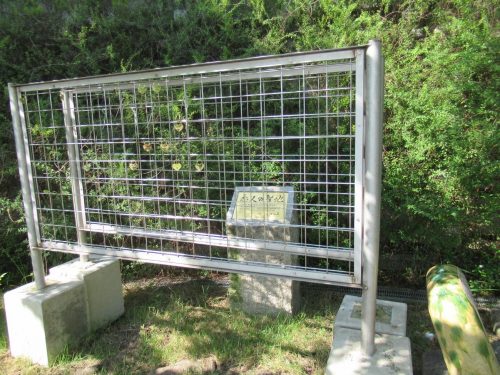
Onomichi was already a hot date spot before the renovations at the PEAK and Onomichi Station, but these two recent additions have made the idea of visiting Onomichi all the more romantic. A refurbished hilltop observatory and a train station hotel overlooking the harbor afford tourists new ways to gaze upon the Seto Inland Sea, and may even up the ante enough to entice them to stay the night, especially if they plan to tackle the Shimanami Kaido. At the same time, these recent refurbishments have not made Onomichi any less traditional of a town, and will only boost the number of tourists who come for the chic cafés, Temple Walk, or seascape vantage points. When all is said and done, I thoroughly enjoyed my day looking upon the Seto Inland Sea from these new venues, but I wouldn’t be satisfied with my Marine Day weekend until I could explore a tourist site closer to sea level.
To be continued…
Written by the Joy in Hiroshima Team
